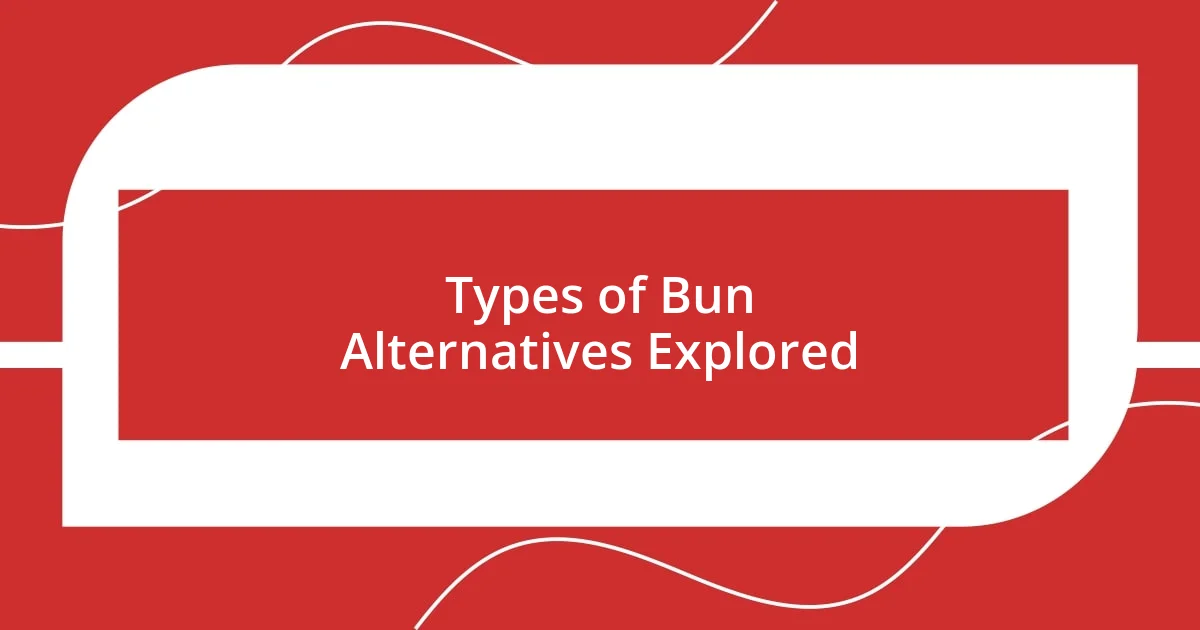Key takeaways:
- Experimenting with bun alternatives, such as portobello mushrooms and avocado, enhances flavor and meal satisfaction while providing healthier options.
- Key ingredients like cauliflower, almond flour, and chickpea flour offer nutritious and creative alternatives to traditional buns, catering to various dietary needs.
- Cooking techniques like grilling, steaming, and baking reveal new textures and flavors, further elevating the dining experience and promoting culinary exploration.

How I Approach Bun Alternatives
When I explore bun alternatives, I start by considering the flavor and texture I want to achieve. For example, one evening, craving something different, I decided to try portobello mushrooms as a base. The satisfaction I felt biting into that juicy, meaty mushroom topped with my favorite ingredients was a delightful surprise—who knew veggies could be so fulfilling?
I also gravitate toward creative solutions like lettuce wraps or sweet potato buns, especially when I’m aiming for a lighter meal. The freshness of the lettuce provides a crisp texture, while the sweetness of the roasted sweet potatoes adds an unexpected twist. Have you ever thought about how the right alternative can completely transform your favorite dish? It’s incredible how a simple switch can affect not just the flavor but how you feel after eating.
Experimentation is key in my kitchen. I love to mix and match ingredients to see what works best. Recently, I combined quinoa with herbs and spices to form a flavorful patty, which I then used as a bun alternative. It was both nutritious and surprisingly hearty, making me wonder what other combinations might be lurking in my pantry!

Types of Bun Alternatives Explored
When experimenting with bun alternatives, I’ve found that using baked eggplants can offer a delightful twist. One night, I was inspired by Mediterranean flavors and created an eggplant stack—it was rich and smoky, making each bite feel like a mini culinary adventure. Honestly, discovering how beautifully versatile eggplants are made my cooking feel more vibrant.
Another alternative I’ve enjoyed is the classic avocado. I once crafted an open-faced sandwich using thick avocado slices as the base; the creamy texture paired perfectly with spicy chicken. It reminded me that sometimes the simplest ideas turn out to be the most enjoyable. Have you ever experienced a dish that completely reevaluated your approach to cooking? That’s what an avocado bun can do.
Let’s not forget about the traditional rice paper wraps. I often use them for a fun, light take on my favorite burgers. I remember a day when I decided to try wrapping a grilled chicken patty inside rice paper, adding a touch of herbs for flavor. It gave a refreshing crunch and was so easy to customize that I couldn’t help but think about all the other fillings I could try next!
| Bun Alternative | Flavor Profile |
|---|---|
| Portobello Mushrooms | Juicy and meaty |
| Baked Eggplants | Rich and smoky |
| Avocado | Creamy and fresh |
| Rice Paper Wraps | Light and crunchy |

Ingredients for Homemade Bun Alternatives
When it comes to crafting my homemade bun alternatives, I pay close attention to the ingredients that not only complement the flavors but also enhance the overall experience. One of my go-to ingredients is cauliflower. I love to blend cauliflower rice with eggs and spices to form a wholesome dough that I can shape into buns. The first time I tried this, I was amazed at how satisfying and filling it turned out, elevating my meal without the heaviness of traditional buns.
I often explore different flours as well, which opens up a world of possibilities. For instance, almond flour gives a nutty flavor and a unique texture. I can still remember the moment I first tasted a burger using almond flour buns—it was both rich and delightful. Here are some key ingredients I often use when experimenting:
- Cauliflower: Offers a light, nutritious base; great for low-carb diets.
- Almond Flour: Adds a nutty flavor, perfect for gluten-free alternatives.
- Chickpea Flour: Great for binding and a source of protein.
- Oats: When ground, they provide a chewy texture and heartiness.
- Zucchini: Perfect for creating soft, moist buns; I love how versatile it is!
Each of these ingredients brings something new to the table, and I can’t help but feel a sense of excitement at the endless combinations I can create.

Techniques for Cooking Bun Alternatives
Cooking bun alternatives requires a bit of creativity and experimentation. One technique I enjoy is grilling portobello mushrooms. Their meaty texture and rich flavor become even more pronounced when they’re charred over high heat. I remember the first time I stacked a grilled portobello with fresh veggies; the umami burst was incredible, and it sparked my curiosity to try different marinades.
Steaming is another method I often use, especially with vegetables like zucchini. There’s something truly satisfying about transforming zucchini into soft, pliable buns. When I had friends over for a barbecue, I made steaming zucchini rounds, and they were a hit! The way they absorbed the burger’s juices while remaining tender was a revelation. Have you ever tried steaming your veggies for a unique twist?
Lastly, I love to experiment with baking alternatives. For instance, I often whip up chickpea flour batter to create my own flatbreads. The first time I took a bite of a warm, baked chickpea bun filled with falafel and tahini, it felt like a culinary revelation! The blend of flavors was so hearty and satisfying, making me wonder what other creations could come from simple ingredients.

Taste Tests of Bun Alternatives
Taste testing bun alternatives is truly a journey of flavors and textures. One unforgettable experience was when I decided to host a taco night with my friends. For the occasion, I made almond flour tortillas and paired them with various fillings. As everyone took their first bites, their smiles said it all. The slight nuttiness of the tortillas complemented the spicy fillings perfectly. Have you ever noticed how the right combination can elevate a meal?
I also adore hosting taste tests just to discover which alternatives resonate most with my palate. A particularly memorable moment happened when I tried making buns with chickpea flour and herbs. The earthy flavor combined with fresh garlic created an explosion of taste that took my burger to the next level. Each bite was filled with a comforting heartiness that made me rethink what a bun could actually be. It’s amazing how one simple tweak in the ingredients can lead to such delightful surprises, don’t you think?
Through my explorations, I’ve come to appreciate the significance of texture in bun alternatives. The first time I experimented with cauliflower bread, I was genuinely stunned by its airy lightness. As I served it with a savory filling, I wondered if anyone else had experienced this delicate balance of flavors and textures. It’s these unexpected moments in cooking that remind me why I keep pushing the boundaries of what we consider a bun—after all, food should be an adventure!

Health Benefits of Bun Alternatives
One of the standout health benefits of bun alternatives is often the reduction in carbohydrates. I distinctly remember the first time I switched out regular buns for large lettuce leaves to wrap my burgers. It felt refreshing and liberating, not to mention I noticed an extra boost in energy afterward. Have you ever felt that lifting sensation after skipping those heavy carbs? That simple switch opened up a world of possibilities for incorporating more nutrient-dense foods into my meals.
Another fantastic aspect is the incorporation of more vegetables and whole food ingredients. I often opt for sweet potato slices instead of traditional bread, and the nutritional punch is undeniable. Not only am I satisfying my craving for something filling, but I’m also nourishing my body with vitamins and minerals. The first time I tried a sweet potato slider topped with avocado and salsa, it was a flavor explosion and a reminder of how healthy food can be delicious too.
Finally, bun alternatives can be a game-changer for those with dietary restrictions. For instance, using chickpea flour in my homemade flatbreads has been such a remarkable experience. Not only are they gluten-free, but they’re also packed with protein! I can still remember the delight I felt when I shared those flatbreads with a friend who had been struggling to find satisfying gluten-free options. Seeing their face light up at the first bite was a moment I won’t forget—it truly reinforced how bun alternatives can bring joy and inclusivity to our meals.

Final Thoughts on Bun Alternatives
Exploring bun alternatives has transformed not just my meals but my entire perspective on flavor and health. I still remember that day when I whipped up some zucchini “buns.” As I assembled my burger, the vibrant green color of the zucchini layers caught my eye. Biting into them was like a light burst of freshness—how can something so simple elevate an ordinary meal so dramatically?
I’ve also learned that bun alternatives don’t just cater to health; they can be incredibly satisfying too. Just the other weekend, I made a delightful chickpea flatbread and paired it with smoky roasted veggies. When my friends took that first bite, their eyes widened in surprise, and I couldn’t help but feel a warm glow in my heart. Isn’t it fascinating how food brings people together, often creating unforgettable experiences without even trying?
Ultimately, the journey of experimenting with bun substitutes is both personal and delightful. Each alternative offers its own unique flavor and texture, reminding me that variety truly is the spice of life. As I sit here reflecting on my experiences, I can’t help but wonder: where will my next culinary adventure take me?















